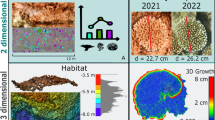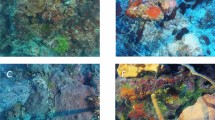Abstract
This paper presents a multi-temporal underwater photogrammetric survey of a reef patch located in Moorea, French Polynesia, designed to detect a coral growth of 10–15 mm/year. Structure-from-Motion photogrammetry and underwater imagery allows the three-dimensional quantification of reef structural complexity and ecologically relevant characteristics at the patch scale. A high degree of accuracy and fine resolution are required in order to guarantee the repeatability of surveys over time within the same reference system, meaning a proper geodetic network and acquisition scheme are mandatory. Measuring tools and reference points were properly designed in order to constrain the photogrammetric reconstruction. The network adjustment, performed with distance and height difference observations, provided an average accuracy of ± 1.2 mm and ± 2.9 mm in the horizontal and vertical components, respectively. The final accuracies of photogrammetric reconstructions are on the order of 1 cm and few millimeters for the 2017 and 2018 monitoring campaigns, respectively. This results in realized errors in the comparison of about ± 1 cm. Coordinate variations larger than this magnitude can be reasonably interpreted as coral growth or dissolution. The direct comparison of the two subsequent point clouds is effective in order to evaluate trends in growth and perform morphometric analyses. For highly accurate quantitative assessment of local changes, an expert operator can create and analyze specific 2D profiles that are easily produced from the point clouds.





Similar content being viewed by others
References
Adam TC, Brooks AJ, Holbrook SJ, Schmitt RJ, Washburn L, Bernardi G (2014) How will coral reef fish communities respond to climate-driven disturbances? Insight from landscape-scale perturbations. Oecologia 176:285–296
Agüera-Vega F, Carvajal-Ramírez F, Martínez-Carricondo P (2016) Accuracy of digital surface models and orthophotos derived from unmanned aerial vehicle photogrammetry. J Surv Eng 04016025. https://doi.org/10.1061/(ASCE)SU.1943-5428.0000206
Bellwood DR, Hughes TP, Folke C, Nystrom M (2004) Confronting the coral reef crisis. Nature 429:827–833
Bessat F, Buigues D (2001) Two centuries of variation in coral growth in a massive Porites colony from Moorea (French Polynesia): a response of ocean-atmosphere variability from south Central Pacific. Palaeogeogr Palaeocol Palaeoecol 175(1):381–392
Bryson M, Ferrari R, Figueira W, Pizarro O, Madin J, Williams S, Byrne M (2017) Characterization of measurement errors using structure-from-motion and photogrammetry to measure marine habitat structural complexity. Ecol Evol 7(15):5669–5681
Burns JHR, Delparte D, Gates RD, Takabayashi M (2015) Integrating structure-from-motion photogrammetry with geospatial software as a novel technique for quantifying 3D ecological characteristics of coral reefs. PeerJ 3:e1077
Capra A (1993) Non-conventional system in underwater photogrammetry. Int Arch Photogramm Remote Sens 29:234–234
Capra A, Dubbini M, Bertacchini E, Castagnetti C, Mancini F (2015) 3D reconstruction of an underwater archaelogical site: comparison between low cost cameras. ISPRS-international archives of the photogrammetry. Remote Sens Spat Inf Sci 40(5W5):67–72
Capra A, Castagnetti C, Dubbini M, Gruen A, Guo T, Mancini F, Neyer F, Rossi P, Troyer M (2017) High accuracy underwater photogrammetric surveying. In 3rd IMEKO international conference on metrology for archaelogy and cultural heritage-MetroArchaeo 2017:696–701
Cinner JE, Maire E, Huchery C, MacNeil MA, Graham NAJ, Mora C, McClanahan TR, Barnes ML, Kittinger JN, Hicks CC, D’Agata S, Hoey A, Gurney GG, Feary DA, Williams I, Kulbicki M, Vigliola L, Wantiez L, Edgar GJ, Stuart-Smith RD, Sandin SA, Green A, Hardt MJ, Beger M, Friedlander A, Wilson SK, Brokovich E, Brooks AJ, Cruz-Motta JJ, Booth DJ, Chabanet P, Gough C, Tupper M, Ferse SCA, Sumaila UR, Pardede S, Mouillot D (2018) The gravity of human impacts mediates coral reef conservation gains. Proc Natl Acad Sci 115(27):E6116–E6125
Collin A, Hench JL, Pastol Y, Planes S, Thiault L, Schmitt RJ, Holbrook SJ, Troyer M, Davies N (2018) Very high resolution mapping of coral reef state using airborne bathymetric LiDAR surface-intensity and drone imagery. Int J Remote Sens 2018:109–119
Drap P, Merad D, Seinturier J, Mahiddine A, Peloso D, Boï J M, Garrabou J (2013) Underwater programmetry for archaeology and marine biology: 40 years of experience in Marseille, France. In 2013 Digital Heritage International Congress (DigitalHeritage) Vol. 1, pp 97–104)
Edmunds PJ (2017) Unusually high coral recruitment during the 2016 El Nino in Mo’orea French Polynesia. PLoS One 12(10):e0185167
Eltner A, Kaiser A, Castillo C, Rock G, Neugirg F, Abellán A (2016) Image-based surface reconstruction in geomorphometry – merits, limits and developments. Earth Surf Dynam 4(2):359–389. https://doi.org/10.5194/esurf-4-359-2016
Fabricus KE, Noonan SHC, Abrego D, Harrington L, De’ath G (2017) Low recruitment due to altered settlement substrata as primary constraint for coral communities under ocean acidification. Proc R Soc B Biol Sci 284(1862):20171536
Ferrari R, Bryson M, BridgeT HJ, Williams SB, Byrne M, Figueira W (2016) Quantifying the response of structural complexity and community composition to environemnetal change in marine communities. Glob Chang Biol 22:1965–1975
Ferrari R, Figueira WF, Pratchett MS, Boube T, Adam A, Kobelkowsky-Vidrio T, Doo S, Atwood TB, Byrne M (2017) 3D photogrammetry quantifies growth and external erosion of individual coral colonies and skeletons. Sci Rep 7:16737
Figueira W, Ferrari R, Weatherby E, Porter A, Hawes S, Byrne M (2015) Accuracy and precision of habitat structural complexity metrics derived from underwater photogrammetry. Remote Sens 7(12):16883–16900
Fonstad MA, Dietrich JT, Courville BC, Jensen JL, Carbonneau PE (2013) Topographic structure from motion: a new development in photogrammetric measurement. Earth Surf Proc Land 38(4):421–430. https://doi.org/10.1002/esp.v38.4
Gardner TA, Cote IM, Gill JA, Grant A, Watkinson AR (2003) Long-term region-wide declines in Caribbean corals. Science 301:958–960
Guo T, Capra A, Troyer M, Gruen A, Brooks A J, Hench J L, Schmitt R L, Holbrook S J, Dubbini M (2016) Accuracy assessment of underwater photogrammetric three dimensional modelling for coral reefs. ISPRS-Int Arch Photogramm Remote Sens Spat Inf Sci 41
Harwin S, Lucieer A, Osborn J (2015) The impact of the calibration method on the accuracy of point clouds derived using unmanned aerial vehicle multi-view stereopsis. Remote Sens 7(9):11933–11953. https://doi.org/10.3390/rs70911933
Hattori A, Shibuno T (2015) Total volume of 3S small patch reefs reflected in aerial photographs can predict total species richness of coral reef damselfish assemblages on a shallow back reef. Ecol Res 30(4):675–682
Holbrook SJ, Schmitt RJ, Adam TC, Brooks AJ (2016) Coral reef resilience, tipping points and the strength of herbivory. Sci Rep 6:35817
Holbrook SJ, Adam TC, Edmunds PJ, Schmitt RJ, Carpenter RC, Brooks AJ, Lenihan HS, Briggs CJ (2018) Recruitment drives spatial variation in rovery rates of resilient coral reefs. Sci Rep 8:7338
Hughes TP, Kerry JT, Álvarez-Noriega M, Álvarez-Romero JG, Anderson KD, Baird AH, Babcock RC, Beger M, Bellwood DR, Berkelmans R, Bridge TC, Butler IR, Byrne M, Cantin NE, Comeau S, Connolly SR, Cumming GS, Dalton SJ, Diaz-Pulido G, Eakin CM, Figueira WF, Gilmour JP, Harrison HB, Heron SF, Hoey AS, Hobbs J-P, Hoogenboom MO, Kennedy EV, Kuo C-Y, Lough JM, Lowe RJ, Liu G, McCulloch MT, Malcolm HA, McWilliam MJ, Pandolfi JM, Pears RJ, Pratchett MS, Schoepf V, Simpson T, Skirving WJ, Sommer B, Torda G, Wachenfeld DR, Willis BL, Wilson SK (2017) Global warming and recurrent mass bleaching of corals. Nature 543:373–377
James M R, Robson S (2012) Straightforward reconstruction of 3D surfaces and topography with a camera: accuracy and geoscience application. J Geophys Res Earth Surf 117(F3)
James MR, Robson S, Smith MW (2017) 3-D uncertainty-based topographic change detection with structure-from-motion photogrammetry: precision maps for ground control and directly georeferenced surveys. Earth Surf Proc Land 42(12):1769–1788
Johnson-Roberson M, Pizarro O, Williams SB, Mahon I (2010) Generation an visualization of large-scale three-dimensional reconstructions from underwater robotic surveys. J Field Robot 27(1):21–51. https://doi.org/10.1002/rob.20324
Kayal M, Lenihan HS, Brooks AJ, Holbrook SJ, Schmitt RJ, Kendall BE (2018) Predicting coral community dynamics using multi-species population dynamics models. Ecol Lett 21(12):1790–1799
Kocak DM, Caimi FM (2005) The current art of underwater imaging with a glimpse of the past and vision of the future. Mar Technol Soc J 39(3):5–26. https://doi.org/10.4031/002533205787442576
Lague D, Brodu N, Leroux J (2013) Accurate 3D comparison of complex topography with terrestrial laser scanner: application to the Rangitikei canyon (NZ). ISPRS J Photogramm Remote Sens 82:10–26
Lenihan HS, Hench JL, Holbrook SJ, Schmitt RJ, Potoski M (2015) Hydrodynamics influence coral performance through simultaneous direct and indirect effects. Ecology 96(6):1540–1549
Mancini F, Dubbini M, Gattelli M, Stecchi F, Fabbri S, Gabbianelli G (2013) Using unmanned aerial vehicles (UAV) for high-resolution reconstruction of topography: the structure from motion approach on coastal environments. Remote Sens 5(12):6880–6898. https://doi.org/10.3390/rs5126880
Menna F, Nocerino E, Fassi F, Remondino F (2016) Geometric and optic characterization of a hemispherical dome port for underwater photogrammetry. Sensors 16(1):48
Mora C (2008) A clear human footprint in the coral reefs of the Caribbean. Proc R Soc B-Biol Sci 275:767–773
Nex F, Remondino F (2014) UAV for 3D mapping applications: a review. Appl Geomat 6(1):1–15
Neyer F, Nocerino E, Gruen A (2018) Monitoring coral growth- the dicotomy between underwater photogrammetry and geodetic control network. ISPRS Int Arch Photogramm Remote Sens Spat Inf Sci 42(2)
Ogundare JO (2015) Precision surveying: the principles and geomatics practice. John Wiley & Sons, pp 267–328
Palma M, Casado MR, Pantaleo U, Cerrano C (2017) High resolution orthomosiacs of African coral reefs: a tool for wide-scale benthic monitoring. Remote Sens 9(7):705
Pennisi E (2002) Survey confirms coral reefs are in peril. Science 297:1622b–1623b
Reichert J, Schellenberg J, Schubert P, Wilke T (2016) 3D scanning as a highly precise, reproducible, and minimally invasive method for surface area and volume measurements of scleractinian corals. Limnol Oceanogr Methods 14(8):518–526
Rossi P, Mancini F, Dubbini M, Mazzone F, Capra A (2017) Combining nadir and oblique UAV imagery to reconstruct quarry topography: methodology and feasibility analysis. Eur J Remote Sens 50(1):211–221
Royer JP, Nawaf MM, Merad D, Saccone M, Bianchimani O, Garrabou J, Drap P (2018) Photogrammetric surveys and geometric processes to analyse and monitor red coral colonies. J Mar Sci Eng 6(2):42
Rupnik E, Nex F, Remondino F (2014) Oblique multi-camera systems–orientation and dense matching issues. ISPRS Int Arch Photogramm Remote Sens Spat Inf Sci 40(3):107. https://doi.org/10.5194/isprsarchives-XL-3-W1-107-2014
Sarakinou I, Papadimitriou K, Georgoula O, Patias P (2016) Underwater 3D modeling: image enhancement and point cloud filtering. ISPRS Int Arch Photogramm Remote Sens Spat Inf Sci 41
Skarlatos D, Agrafiotis P, Menna F, Nocerino E, Remondino F (2017) Ground control networks for underwater photogrammetry in archaeological excavations. In Proceedings of the 3rd IMEKO International Conference on Metrology for Archaeology and Cultural Heritage. MetroArcheo 2017 October 23–25, 2017, Lecce, Italy
Snavely N, Seitz SM, Szeliski R (2006) Photo tourism: exploring photo collections in 3D. ACM T Graph 25(3):835–846
Suchley A, Alavarez-Filip L (2018) Local human activities limit marine protection efficacy on Caribbean coral reefs. Conserv Lett 11(5):UNSPe12571
Toschi I, Rivola R, Bertacchini E, Castagnetti C, Dubbini M, Capra A (2013) Validation tests of open-source procedures for digital camera calibration and 3D image-based modelling. ISPRS Int Arch Photogramm Remote Sens Spat Inf Sci XL-5/W2:647–652. https://doi.org/10.5194/isprsarchives-XL-5-W2-647-2013
Trapon ML, Pratchett MS, Adjeroud M, Hoey AS, Baird AH (2013) Post-settlement growth and mortality rates of juvenile scleractinian corals in Moorea, French Polynesia versus Trunk Reef, Australia. Mar Ecol Prog Ser 488:157–170
Acknowledgments
We would like to thank R. J. Schmitt and S. J. Holbrook, UC Santa Barbara, as well as A. Gruen and M. Troyer, ETH Zurich, for their contributions to this project. We also would like to thank E. Nocerino and F. Neyer, ETH Zurich, for thoughtful discussions and advice on data processing. Research was completed under permits issued by the French Polynesian Government (Délégation à la Recherche) and the Haut-commissariat de la République en Polynésie Francaise (DTRT) (Protocole d’Accueil 2005–2018).
Funding
This work was partially supported by the U.S. National Science Foundation under Grant No. OCE 16-37396 (and earlier awards) as well as a generous gift from the Gordon and Betty Moore Foundation
Author information
Authors and Affiliations
Corresponding author
Additional information
Publisher’s note
Springer Nature remains neutral with regard to jurisdictional claims in published maps and institutional affiliations.
Rights and permissions
About this article
Cite this article
Rossi, P., Castagnetti, C., Capra, A. et al. Detecting change in coral reef 3D structure using underwater photogrammetry: critical issues and performance metrics. Appl Geomat 12 (Suppl 1), 3–17 (2020). https://doi.org/10.1007/s12518-019-00263-w
Received:
Accepted:
Published:
Issue Date:
DOI: https://doi.org/10.1007/s12518-019-00263-w




